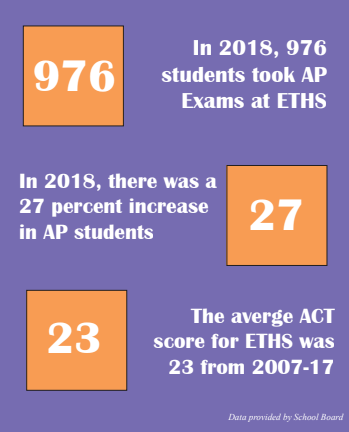Data shows increased student achievement

April 26, 2019
Information presented at the Feb. 11 school board meeting showed a historical trend of increased AP involvement, AP scores of 3 or higher and ACT scores.
Data regarding student achievement is compiled annually or semiannually to present to the school board in order to effectively analyze the success of school goals and programs.
“We get regular reports on student achievement… It’s how you measure the activities students are engaged in, the goals the board puts forth, are effective. Then the administration, the superintendent creates programs to maximize student achievement,” school board member Jonathan Baum explained.
Assistant Superintendent for Curriculum and Instruction Pete Bavis, the ETHS Office of Research and Assessment and Team ASAP all contribute to the reports. It is Bavis’ responsibility to write the overall reports.
“We do a snapshot of student data and it normally goes back a couple years. We decided that it would be nice to have a longer view of student achievement to take stock of where we are and what we’ve done and what we need to do going forward. Very rarely do we look historically going back 10 or more years, very rarely do we go back more than two years,” Bavis said.
According to the report, in 2018, 976 unique students took AP exams. Unique students are defined as an individual student who takes one or more AP classes. This was a 27 percent increase in unique AP students since 2011-12.
The data was also separated by racial groups. All groups saw an increase in AP participation and scores. In 2017-18, 29 percent of black juniors or seniors, 57 percent of Hispanic or Latino juniors or seniors and 77 percent of white juniors or seniors took one or more AP exams.
“Ideally, if a certain amount of white students are taking AP classes, then you want the same percentage of your black students to be taking AP classes, so that’s a metric that some schools use…If you look at our data it has jumped, but we have some work to do,” Mathematics Department Chair and AP Success Manager Dale Leibforth explained.
At the same meeting, data was also presented on ACT scores from 1972-2017. Over this period of time, there has been an increase in ETHS students’ scores. From 2008-2017, the average ETHS score was above 23.
The school only started separating ACT scores based on race starting in 2007. ETHS, like other Illinois public schools, no longer requires students to take the ACT. Now, all juniors are required to take the SAT. Due to the recency of the switch, there is currently insufficient data of SAT scores to formulate a trend.
The Northwestern Evanston Educator Research Alliance examined data comparing the number of AP tests students took throughout high school and persistence in college. They found that “the percentage of students who persist for five contiguous semesters levels off at around 3 or 4 AP tests.”
“We also have well being goals…we’re not just academic machines here. We realize that students are complicated, complex, and need support and need care along the way so that they their social, emotional, and academic potential,” Bavis said.
Team ASAP aims to increase AP involvement and success in AP classes through awareness, access, readiness, and continued support. There are a variety of school resources that help to provide this support.
One of the methods of providing access for AP is through detracking. Freshmen humanities switched to an earned honors credit model in 2011-12. Since the 2012-13 school year other classes across all departments were detracked. For the first time this year, Geometry classes are following a pathway to honors model.
“For a lot of the freshmen, their entire freshman year is detracked,” Leibforth said.
Although data regarding student success and achievement is mostly measured quantitatively, ETHS can also gather information hearing from students personally.
“We do focus groups with students. Students help facilitate those focus groups and participate in the data analysis of those focus groups. That doesn’t get reported to the board right now. We have an internal document that then goes to the teachers of the course. The idea is that they would then make modifications to their curriculum and instruction based on the feedback,” Bavis explained.
Team ASAP hosts monthly lunches where students facilitate conversations about their experiences in AP classes.
“If we hear at every lunch meeting again and again that there’s some kind of challenge, that’s an evaluation of our AP program that we work to change for the better… I think that’s where we get that more qualitative data as well. We haven’t done an official survey,” Leibforth said.
It is the combination of multiple programs that have allowed for data showing an increase in student success.
“I don’t think we can say it’s any one thing, but it’s a combination of all of those factors is a better way to grow. If we just did one thing I don’t think we would grow. It’s hard to isolate what the impact of any one of those is. In total, we’ve grown and developed as an institution,” Bavis said.









